These days, on Earth we recycle our waste almost without even thinking about it, but what about future Moon explorers? Will they be able to recycle on the Moon?
It seems we're getting ever closer to a permanent human settlement on the Moon.
Just as the International Space Station ushered in an era of permanent human presence in Earth orbit, NASA's Artemis programme is set to ensure there are always humans living and working on the lunar surface.

But with the prospect of lunar occupation come issues such as how to produce materials, how to build things and, perhaps most importantly, how to remove waste created during these processes.
If life on Earth has taught us anything, it's that waste management on the Moon needs to be carefully planned and fine-tuned in the early stages.
And with frequent lunar missions on the horizon, focus is now turning to the sustainable use and reuse of the materials that will be left on the surface.
We spoke to Geoffrey Brooks, professor of engineering at Swimburne University of Technology, to find out whether recycling on the Moon is possible, and how it might be done.

How important is recycling human-made materials on the Moon?
The idea of having a habitat on the Moon was for a long time one for the distant future, but a few years ago it became apparent that the idea had become more of a serious one.
At the same time, space companies such as SpaceX are trying to bring down the cost of launching things into space.
However, once you’ve got the costs down, and once you can think about putting a habitat on the Moon, you then have the same issues that we have on Earth:
How do you make stuff? How do you use it? How do you reuse it?
So I set up a group to work with me on all aspects of how we can make things on the surface of the Moon, drawing on my background in extractive metallurgy.
How can we recycle materials on the Moon?
We’re looking at the furnace technology best suited to recycling on the Moon, which uses concentrated solar energy as a source of heat.
Ten years ago, I started getting involved with solar thermal energy and I’ve done a lot of research about that here on Earth.
One of the very attractive things about solar on the Moon is you get 14 days of constant sunshine – no clouds.
We don’t know the exact timings for getting it off the ground, but there is already serious investment in the area and we’re working with various companies specialising in lunar resources.

What are the challenges surrounding recycling on the Moon?
When you start looking closely, you realise there are special challenges associated with the Moon.
For example, when you recycle aluminium you typically have various impurities.
So when we melt aluminium to get rid of some of those things, we then try to get those impurities removed by putting bubbles through, trying to accelerate them to the surface.
But we have to take into consideration that gravity on the Moon is one sixth of Earth’s, so the processes that work well here won’t work as well on the Moon.
However, the Moon has a high vacuum that could work to our advantage. In metallurgy there are certain times when you want a vacuum to get high purity.
For example, you might want to remove dissolved gases and it’s common to use a high vacuum to do this.
However, we don’t want to keep flying crucibles up every time we want to melt something, so we will have to make crucibles with the materials already on the Moon.
How we do this is something my team is working on.
What happens if we don't recycle leftover materials on the Moon?
There’s an ethical aspect to recycling on the Moon, but there’s also an archaeological human history aspect to what’s left on the Moon from the Apollo missions.
These are incredibly important sites to humanity and I think we should start to think about how to preserve those artefacts.
It’s unlikely that leftover bits of metal will cause damage to the Moon, because it’s not going to rust and probably not going to contaminate anything.
But I think we should start taking some control from an aesthetic perspective and the long-term viability of having people on the Moon.

When will recycling on the Moon become a reality?
In terms of timelines, we’re looking a little bit further into the future.
Rather than fly a full-scale solar furnace to the Moon right now, we could get a solar concentrator, like a Fresnel lens [a flat lens made from a series of concentric rings] system set up.
On the Moon, there’s no cloud – just brilliant sunshine.
You could use that for making ceramics, melting metals, for all sorts of thermal activity.
I think that we could see that happen in the next three or four years. In terms of the recycling side of things, I think that’s more like 10 years.
This interview originally appeared in the August 2022 issue of BBC Sky at Night Magazine.
